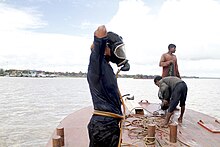| Yangon River Hlaing River | |
|---|---|
 Yangon River | |
| Native name | လှိုင်မြစ် (Burmese) |
| Location | |
| Country | Myanmar |
| City | Yangon (also known as Rangoon) |
| Physical characteristics | |
| Mouth | |
• location | Andaman Sea |
• elevation | 0 m (0 ft) |
| Discharge | |
| • location | Gulf of Martaban |
The Yangon River (also known as the Rangoon River or Hlaing River) is formed by the confluence of the Pegu and Myitmaka Rivers in Myanmar. It is a marine estuary that runs from Yangon (also known as Rangoon) to the Gulf of Martaban of the Andaman Sea. The channel is navigable by ocean-going vessels, thus plays a critical role in the economy of Myanmar.

The Twante Canal connects the Yangon River with the Irrawaddy Delta, once known as 'the rice bowl of Asia'. It consists of 1,000 square miles (3,000 km2) of lush teak plantations and mangrove swamps, many of which have now been cleared for rice production.
References
[edit]16°28′N 96°20′E / 16.467°N 96.333°E
Well, that’s interesting to know that Psilotum nudum are known as whisk ferns. Psilotum nudum is the commoner species of the two. While the P. flaccidum is a rare species and is found in the tropical islands. Both the species are usually epiphytic in habit and grow upon tree ferns. These species may also be terrestrial and grow in humus or in the crevices of the rocks.
View the detailed Guide of Psilotum nudum: Detailed Study Of Psilotum Nudum (Whisk Fern), Classification, Anatomy, Reproduction